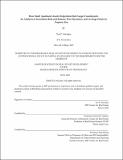| dc.contributor.advisor | Geltner, David M. | |
| dc.contributor.author | Nicolais, Teo P. | |
| dc.date.accessioned | 2022-08-29T16:02:52Z | |
| dc.date.available | 2022-08-29T16:02:52Z | |
| dc.date.issued | 2022-05 | |
| dc.date.submitted | 2022-05-09T18:39:55.245Z | |
| dc.identifier.uri | https://hdl.handle.net/1721.1/144660 | |
| dc.description.abstract | The 26 million‐unit, 558,0000‐property U.S. apartment property market exhibits remarkable heterogeneity when it comes to property size. And despite all the efficiencies one would expect to see in a $5.1 trillion asset market, two surprising patterns emerge: small apartment properties persistently outperform large apartment properties on a risk‐adjusted basis and institutional investors inexplicably avoid the market for small properties.
Based on academic literature, industry research, and original empirical analysis, this paper identifies six apartment property size categories (by unit count). It explores key leverage points that arise from the fundamental nature of properties of different sizes, investors of different types, and the interaction thereof. It delineates the range of property size over which the comparative advantages of certain investors achieve their maximum effect and over what ranges their influence wanes. Using tools of analysis pioneered at the MIT Center for Real Estate and MIT Sloan this thesis undertakes a rigorous exploration of each property size tier, providing new insights into the understudied market for small apartment properties.
Using property‐level data from over 77,000 transactions between 2000 to 2018 this paper (1) analyses the ownership segmentation of the market and measures the strength of investor affinity for certain sized properties, (2) uses repeat‐sales regression analysis to develop commercial property price indices to capture price dynamics and investment risk / returns profiles, (3) analyzes property‐level holding period returns (i.e., the IRRs) for nearly 23,000 round‐trip investments, and (4) builds a Monte Carlo simulation model to test and evaluate property‐size based investment strategies. | |
| dc.publisher | Massachusetts Institute of Technology | |
| dc.rights | In Copyright - Educational Use Permitted | |
| dc.rights | Copyright retained by author(s) | |
| dc.rights.uri | https://rightsstatements.org/page/InC-EDU/1.0/ | |
| dc.title | How Small Apartment Assets Outperform their Larger Counterparts: An Analysis of Investment Risk and Returns, Price Dynamics, and Leverage Points by Property Size | |
| dc.type | Thesis | |
| dc.description.degree | S.M. | |
| dc.contributor.department | Massachusetts Institute of Technology. Center for Real Estate. Program in Real Estate Development. | |
| mit.thesis.degree | Master | |
| thesis.degree.name | Master of Science in Real Estate Development | |
